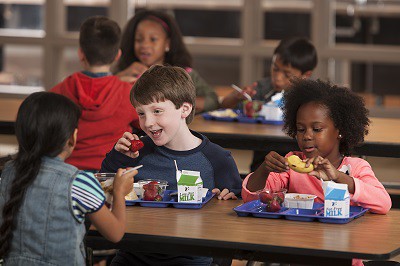
Promoting Healthy Choices Throughout the School Day
Schools across the country are working hard to ensure students experience a healthy school environment from the moment they walk in the door until the final bell rings. Imagine for a second that you are back in sixth grade. In health class, you’re learning about the food groups and how to eat a balanced diet. During P.E. class, your teacher stresses the importance of exercise and leading a healthy lifestyle. School breakfast and lunch included colorful fruits and vegetables, whole grains, and lean protein. In between periods you are hungry for an afternoon snack from the school’s vending machine. Your eye catches a glimpse of a flashy picture of a bottle of water with a logo down the side of the vending machine, and you think to yourself that water would be a great thirst quencher. Still, you scan the vending machine and see that your options are bottles of water, 100 percent juices, and unsweetened tea—all healthy options! You are thrilled that the school is supporting your resolve to maintain a healthy lifestyle by making healthy choices so readily available. Feeling good about the choices you’ve made so far that day, you are able to choose a healthy snack to compliment the healthy meals you have eaten throughout the day.
Since the passage of the Healthy, Hunger-Free Kids Act of 2010 (HHFKA), school nutrition professionals have been working tirelessly to ensure that kids have access to nutritious, balanced meals…and the progress they’ve made is nothing less than impressive. More than 98 percent of schools across the country now meet the updated school nutrition standards. To make the healthy choice the easier choice for kids, now schools will have additional support creating healthy school environments that promote positive choices through the entire school day.
That’s why USDA is publishing the Local School Wellness Policy and the Smart Snacks in School final rules. The Local School Wellness Policy final rule puts in place common-sense standards on any food or beverage marketing targeted at kids during the school day. Seventy percent of elementary schools have some kind of food or beverage marketing. This messaging surrounds students in their place of learning; therefore, it is vital that it is consistent with what they are being taught through nutrition education. The Smart Snacks in School final rule also helps ensure consistency by implementing nutrition standards on foods that are sold to children outside of school breakfast or lunch meals. The standards in these two final rules will help equip students to make healthy choices not only during the school day, but also outside of school and throughout the rest of their lives.
The Local School Wellness Policy final rule also requires schools to solicit stakeholder participation in the annual development of local school wellness policies. This empowers parents and communities to take an active role in the health of their children. USDA also recently published the Community Eligibility Provision final rule and the Administrative Review Process final rule, which strengthen access to school meals and increase integrity and compliance in school meal programs, respectively.
Together, these rules play a pivotal role in encouraging today’s youth to continue to make healthy food choices by promoting consistency, collaboration, access, and integrity. The standards build on the positive, incremental changes we’ve seen under HHFKA and further the ultimate goal of building a healthier next generation.
No comments:
Post a Comment
Note: Only a member of this blog may post a comment.